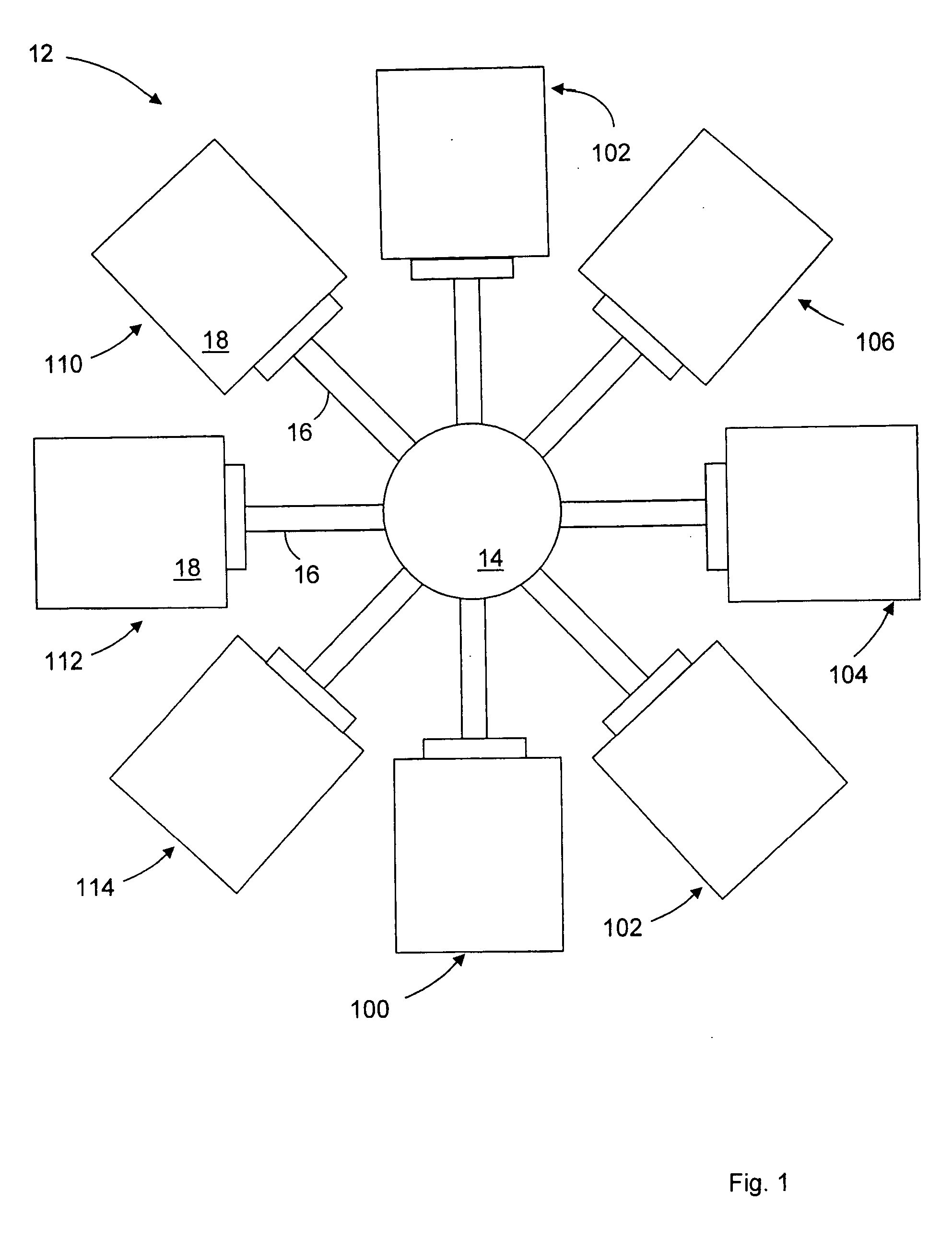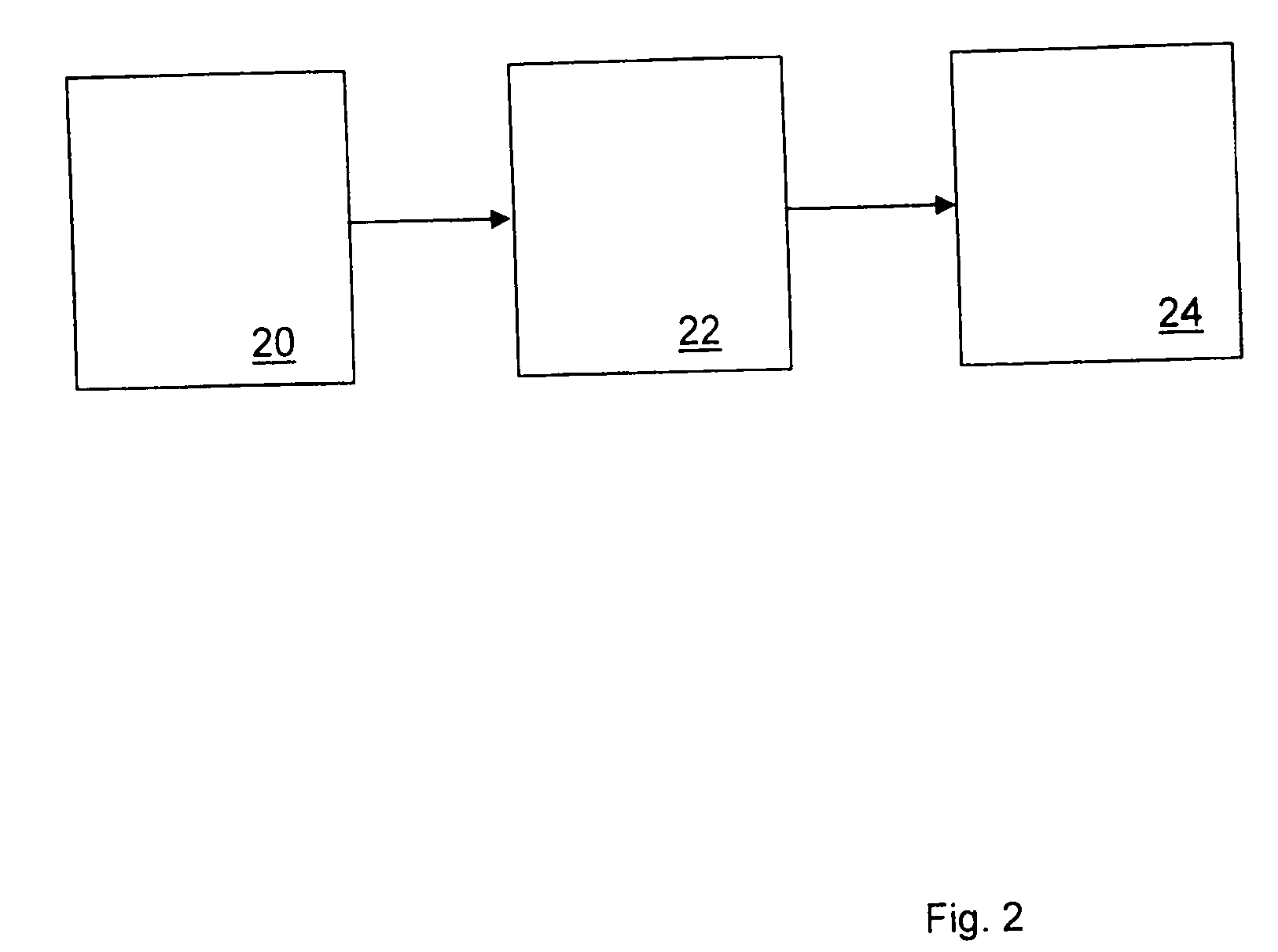Method for inkjet printing light colors on dark textiles
a technology of inkjet printing and dark textiles, applied in printing, typewriters, office printing, etc., can solve the problems of time-consuming and laborious, certain textiles do not screen print well, and dark textiles are the hardest to screen prin
- Summary
- Abstract
- Description
- Claims
- Application Information
AI Technical Summary
Benefits of technology
Problems solved by technology
Method used
Image
Examples
first embodiment
[0014] method 10 uses a rotary press 12. Rotary press 12 is preferably a rotary speed table and comprises a base 14 with a series of arms 16, each of which supports a platen 18 which carries the textile being printed. As shown in FIG. 1, platens 18 rotate about an axis on base 14 to enable each platen 18 to pass through a series of stations 100-114 wherein a different step in method 10 occurs. Method 10 will now be described in detail by way of example.
[0015] A textile item such as a garment is loaded on platen 18 of a rotary press 12 at station 100. Platen 18 is rotated to station 102 wherein ink is screen printed onto the textile to form the underbase by a screen print head using known screen printing methods. In the preferred embodiment, the underbase is a light color such as white and is opaque, such as that created with plastisol garment screen printing ink, waterbased garment screen printing ink, or discharge garment screen printing ink. The underbase may have varying degrees ...
second embodiment
[0018] The second embodiment also uses rotary press 12, but eliminates curing the underbase thereby skipping station 104 and proceeding directly to station 106. Eliminating the curing step is dependent upon which type of ink is screen-printed onto the textile at station 102 as is known in the art. The textile is loaded on platen 18 of a rotary press 10 at station 100 before being rotated to station 102 where a light opaque image (preferably white) is screen-printed onto the textile to form the underbase. Platen 18 is then rotated to station 106 where the desired image is inkjet printed onto the textile. Optionally, platen 18 may be rotated to station 112 to cure the inkjet ink. The textile is then removed from the platen 18 at station 114.
[0019]FIG. 2 illustrates a third embodiment of method 10 using a single-shirt printing press 20. First, the textile is laid onto printing press 20. Then, using known methods, the preferably light-colored underbase is screen printed on the textile u...
fourth embodiment
[0020] The fourth embodiment also uses printing press 20, but eliminates curing the underbase with curing apparatus 22. Instead, the underbase is screen printed on the textile using printing press 20 before the desired image is inkjet printed on top of the underbase by inkjet printer 24.
[0021] In the embodiments described herein, the screen print head, inkjet printer, and the cure units may be stand-alone devices that operate independently, or they may be interconnected to cooperate with each other and the rotary press 12.
[0022] As can be seen, method 10 provides for an efficient process of printing images on textiles such as garments. Method 10 enables for light-colored inks such as white ink to be easily applied to dark textiles such as black t-shirts with relative ease by combining the screen printing technology with inkjet printing.
PUM
 Login to View More
Login to View More Abstract
Description
Claims
Application Information
 Login to View More
Login to View More - R&D
- Intellectual Property
- Life Sciences
- Materials
- Tech Scout
- Unparalleled Data Quality
- Higher Quality Content
- 60% Fewer Hallucinations
Browse by: Latest US Patents, China's latest patents, Technical Efficacy Thesaurus, Application Domain, Technology Topic, Popular Technical Reports.
© 2025 PatSnap. All rights reserved.Legal|Privacy policy|Modern Slavery Act Transparency Statement|Sitemap|About US| Contact US: help@patsnap.com



